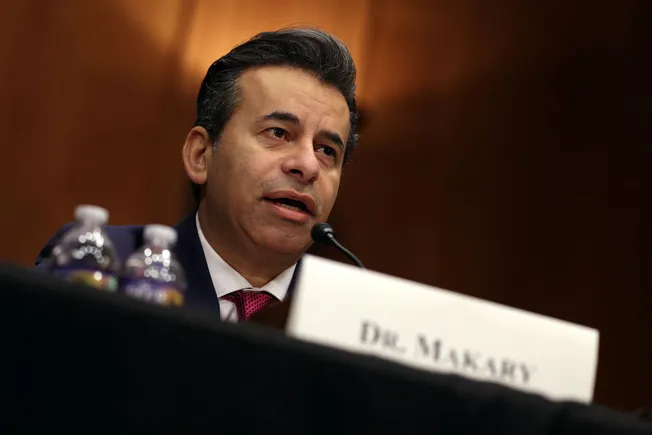The D Brief: US strikes in Somalia; UAE seeks DOGE’d DOD workers; Trump-Putin talks fall flat; Genius Machines on Thursday; And a bit more.
The Navy’s top officer said U.S. forces carried out “the largest air strike in the history of the world” during recent operations near Somalia. Acting Chief of Naval Operations Adm. James Kilby shared the extraordinary remarks Monday evening at the Council on Foreign Relations’ Robert B. McKeon Endowed Series on Military Strategy and Leadership, which is typically a polite, news-free event every spring. Kilby was speaking about U.S. military operations in the Red Sea, where U.S. forces had been carrying out intense airstrikes against Houthi militants inside Yemen since March 15. But less than two months later, President Trump stopped the airstrikes after the loss of multiple attack drones and Super Hornet aircraft that slid off the deck of Navy aircraft carriers during defensive maneuvers to avoid Houthi missiles and drones. The USS Truman carrier strike group engaged an estimated 160 missiles and drones aimed at either Israel or vessels transiting the coast of Yemen while U.S. forces operated in the Red Sea over the past five months, Kilby said Monday evening. “They conducted 670 strikes” and “launched the largest air strike in the history of the world—125,000 pounds from a single aircraft carrier into Somalia,” Kilby said. (Hat tip to Paul McCleary of Politico for flagging Kilby’s stats on social media.) “That single strike group worked for three different combat commanders in the execution of that mission for five months,” said Kilby. Panning out: The U.S. military in Africa has attacked predominantly ISIS positions in northern Somalia on at least 10 separate occasions since March 17, and at least twice since Trump ordered a halt to U.S. strikes inside Yemen earlier this month. However, U.S. officials have not shared battle damage assessments from these strikes in more than a month and a half when they last claimed “multiple enemy combatants were killed and that no civilians were injured or killed” in a strike on April 1. Recall that Trump’s national security team worried Somalia could be on the brink of collapse not because of ISIS, but because the terrorist group al-Shabaab has been making steady battlefield gains closer to Mogadishu, the New York Times reported on April 10. At the time, some State Department officials proposed “closing the U.S. embassy in Mogadishu and withdrawing most American personnel as a security precaution,” but others “in the National Security Council, [were] worried that shutting the embassy could diminish confidence in Somalia’s central government and inadvertently incite a rapid collapse,” officials told the Times. Developing: U.S. and Emirati officials signed a “letter of intent” to begin work on what Pentagon chief Pete Hegseth’s team called “a structured roadmap that will guide enhanced military-to-military cooperation,” defense officials announced Monday. The Defense Department’s statement is long on ambition but short on specifics—emphasizing, e.g., “a phased framework for advancing bilateral force readiness, interoperability, and innovation-driven collaboration.” The new plans, such as they are, also involve the Pentagon’s Defense Innovation Unit teaming up with the UAE’s Tawazun Council as well as a parallel effort to integrate Emirati officials “into the U.S. National Guard State Partnership Program through a partnership with the Texas National Guard.” That program is intended to “enhance cooperation in integrated air and missile defense, cybersecurity, disaster response, and operational planning,” Hegseth’s staff said. Read more, here. By the way: The UAE is recruiting DOGE’d Pentagon employees for work on an AI project in Abu Dhabi “despite past warnings from U.S. spy agencies and federal lawmakers that [the] UAE could share AI technologies with China,” investigative journalist Kim Zetter reported Tuesday for Zero Day. Commentary: The U.S. needs a “security clearance ready reserve,” argues Lindy Kyzer, vice president of ClearanceJobs.com. “Just because you’re out of a contract doesn’t mean your clearance eligibility goes away,” she writes. “When the focus is on the agency, and not the individual, the investment the government has made in a clearance ($5,410 for a Top Secret clearance investigation conducted by the Defense Counterintelligence and Security Agency) isn’t treated as the resource it is.” “The idea isn’t new,” she reminds readers. The Defense Innovation Board recommended the concept in a 2024 report about driving innovation in the defense industrial base. The report noted the numerous benefits of the type of “enduring reciprocity” Continuous Vetting enables. The vision: treat cleared personnel like an elite national resource, not a disposable line item. Continue reading, here. Alert: Later this afternoon, Trump is expected to announce developments related to his ambitious “Golden Dome” missile-defense project that could be a boon for defense contractors like SpaceX, Anduril and others. Bloomberg last week reported some sort of devel

Kilby was speaking about U.S. military operations in the Red Sea, where U.S. forces had been carrying out intense airstrikes against Houthi militants inside Yemen since March 15. But less than two months later, President Trump stopped the airstrikes after the loss of multiple attack drones and Super Hornet aircraft that slid off the deck of Navy aircraft carriers during defensive maneuvers to avoid Houthi missiles and drones.
The USS Truman carrier strike group engaged an estimated 160 missiles and drones aimed at either Israel or vessels transiting the coast of Yemen while U.S. forces operated in the Red Sea over the past five months, Kilby said Monday evening.
“They conducted 670 strikes” and “launched the largest air strike in the history of the world—125,000 pounds from a single aircraft carrier into Somalia,” Kilby said. (Hat tip to Paul McCleary of Politico for flagging Kilby’s stats on social media.) “That single strike group worked for three different combat commanders in the execution of that mission for five months,” said Kilby.
Panning out: The U.S. military in Africa has attacked predominantly ISIS positions in northern Somalia on at least 10 separate occasions since March 17, and at least twice since Trump ordered a halt to U.S. strikes inside Yemen earlier this month. However, U.S. officials have not shared battle damage assessments from these strikes in more than a month and a half when they last claimed “multiple enemy combatants were killed and that no civilians were injured or killed” in a strike on April 1.
Recall that Trump’s national security team worried Somalia could be on the brink of collapse not because of ISIS, but because the terrorist group al-Shabaab has been making steady battlefield gains closer to Mogadishu, the New York Times reported on April 10. At the time, some State Department officials proposed “closing the U.S. embassy in Mogadishu and withdrawing most American personnel as a security precaution,” but others “in the National Security Council, [were] worried that shutting the embassy could diminish confidence in Somalia’s central government and inadvertently incite a rapid collapse,” officials told the Times.
Developing: U.S. and Emirati officials signed a “letter of intent” to begin work on what Pentagon chief Pete Hegseth’s team called “a structured roadmap that will guide enhanced military-to-military cooperation,” defense officials announced Monday.
The Defense Department’s statement is long on ambition but short on specifics—emphasizing, e.g., “a phased framework for advancing bilateral force readiness, interoperability, and innovation-driven collaboration.” The new plans, such as they are, also involve the Pentagon’s Defense Innovation Unit teaming up with the UAE’s Tawazun Council as well as a parallel effort to integrate Emirati officials “into the U.S. National Guard State Partnership Program through a partnership with the Texas National Guard.” That program is intended to “enhance cooperation in integrated air and missile defense, cybersecurity, disaster response, and operational planning,” Hegseth’s staff said. Read more, here.
By the way: The UAE is recruiting DOGE’d Pentagon employees for work on an AI project in Abu Dhabi “despite past warnings from U.S. spy agencies and federal lawmakers that [the] UAE could share AI technologies with China,” investigative journalist Kim Zetter reported Tuesday for Zero Day.
Commentary: The U.S. needs a “security clearance ready reserve,” argues Lindy Kyzer, vice president of ClearanceJobs.com. “Just because you’re out of a contract doesn’t mean your clearance eligibility goes away,” she writes. “When the focus is on the agency, and not the individual, the investment the government has made in a clearance ($5,410 for a Top Secret clearance investigation conducted by the Defense Counterintelligence and Security Agency) isn’t treated as the resource it is.”
“The idea isn’t new,” she reminds readers. The Defense Innovation Board recommended the concept in a 2024 report about driving innovation in the defense industrial base. The report noted the numerous benefits of the type of “enduring reciprocity” Continuous Vetting enables. The vision: treat cleared personnel like an elite national resource, not a disposable line item. Continue reading, here.
Alert: Later this afternoon, Trump is expected to announce developments related to his ambitious “Golden Dome” missile-defense project that could be a boon for defense contractors like SpaceX, Anduril and others. Bloomberg last week reported some sort of developments were in the works, and could include “a draft architecture.” Stay tuned at DVIDS for more around 3 p.m. ET; link here.
Additional reading:
- “Retired four-star Navy Adm. Robert P. Burke guilty of bribery,” the Washington Post reported Monday;
- “Sources contradict Trump narrative about Qatar offering plane as ‘gift’,” CNN reported Monday;
- “Striking Pratt engine workers to resume talks with RTX on Thursday,” Reuters reported Monday;
- “Army anniversary parade on Trump's birthday could cost up to $45 million,” CBS News reported Friday;
- “Judge Rules That Trump Administration Takeover of Institute of Peace Is Illegal,” the New York Times reported Monday;
- And “ICE agents to join Marines screening visitors at Camp Pendleton gates,” the Times of San Diego reported Friday.
Welcome to this Tuesday edition of The D Brief, a newsletter dedicated to developments affecting the future of U.S. national security, brought to you by Ben Watson and Patrick Tucker. Share your tips and feedback here. And if you’re not already subscribed, you can do that here. On this day in 1949, the National Security Agency was established.
Putin’s Ukraine invasion, day 1182
Europe piles sanctions on Russia following Trump’s call with Putin. Trump on Truth Social yesterday characterized the two-hour call with the Russian leader as “excellent,” and promised that Russia and Ukraine would “immediately start negotiations toward a Ceasefire.” The problem is: that’s not the same as a ceasefire, which is what Ukraine and the EU are demanding.
The EU announced its 17th package of sanctions against Russia on Tuesday, targeting Russia’s “shadow fleet,” of third-party shipping partners as well as Russian energy, industry, and individuals. German Foreign Minister Johann Wadephul declared, “We have made clear again and again that we simply expect one thing from Russia now: namely, a ceasefire, unconditional and immediate,” according to the Associated Press.
“While Putin feigns interest in peace, more sanctions are in the works,” promised Kaja Kalla, the EU’s high representative for foreign affairs and security policy.
The view from Kyiv: Ukrainian President Volodymyr Zelenskyy said on X “It is obvious that Russia is trying to buy time in order to continue its war and occupation.”
Related reading: “Zelensky’s Attempt to Get Trump on His Side Falls Flat,” the Wall Street Journal reported Tuesday.
Forecast: Russian attacks on Ukraine will likely persist over the summer, said Jack Watling of the London-based Royal United Services Institute in a commentary published Tuesday. He expects Russia to focus efforts on the areas of Kostyantynivka and Pokrovsk and intensify its attacks in the buildup of the June NATO Summit in the Hague.
Also: Russia has taken to more deliberate targeting of radar stations to knock out Ukraine UAV operations and is now bombing hotels hosting reporters, Reporters Without Borders announced in a report published Friday.
Genius Machines are coming Thursday
And lastly: OpenAI, Scale AI, and representatives from U.S. European Command will join Defense One’s science and tech editor Patrick Tucker to reveal how large language models and other cutting-edge AI tools are reshaping the U.S. military’s approach to China, Russia, and beyond.
The first installment of Genius Machines 2025 launches Thursday. For more details on the agenda and registration (which is required, but it’s free), go here. ]]>






















































































































































